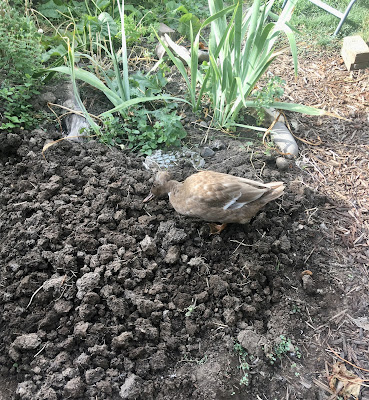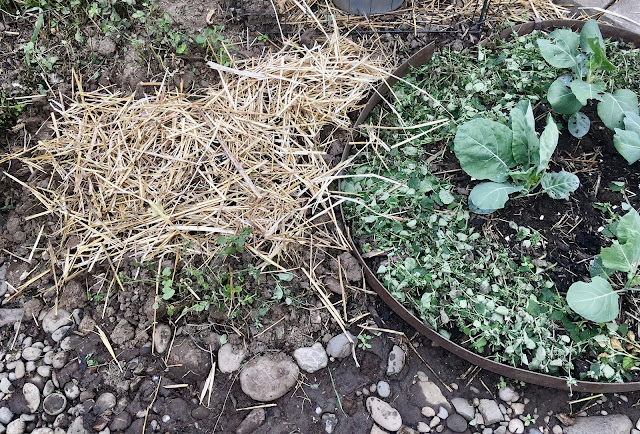September is always dry here in our valley, but this year the heat continued well beyond average. The garden is looking wilted and dusty, and the soil is exhausted. And the smoke from nearby fires is back, limiting my healthy time outdoors.
But the weather is starting to cool off, so (when the air quality allows) my goal is to get the garden in order this month, with no weeds, dead wood, weak plants, or disease - only the sweet smells of the flowers and fruits. With a little effort now the garden will shine for two more months with fall blooms and delicious vegetables.
 |
| Permelia, helping to prepare a bed. |
All in the garden is changing, aging, ripening, and setting seed. Very soon this sweet summer spell will be broken, and winter will be upon us. Grounding and a good connection to the earth makes the big changes go smoother. I stand firmly planted in my garden and call on my quiet inner strength and solidity to sustain me through the confusion of transition.
Agenda:
1. Read "The Earth Path"
1. Read "The Earth Path"
2. Extend the season
3. Weeding and green mulching
4. Fall planting
5. Harvest and preserve
6. Save seeds
4. Fall planting
5. Harvest and preserve
6. Save seeds
1. Read "The Earth Path":
 I'm reading Starhawk's book, The Earth Path (2004), which is all about how to connect to nature. I'm in the middle of Chapter 3, The Sacred: Earth-Centered Values, where she outlines her framework for her earth-based spirituality. I left off with a discussion of the interplay of consciousness, energy, and matter - how, for example, having enough to eat affects our sense of well-being, and how feelings we have affect our actions.
I'm reading Starhawk's book, The Earth Path (2004), which is all about how to connect to nature. I'm in the middle of Chapter 3, The Sacred: Earth-Centered Values, where she outlines her framework for her earth-based spirituality. I left off with a discussion of the interplay of consciousness, energy, and matter - how, for example, having enough to eat affects our sense of well-being, and how feelings we have affect our actions.The next sub-section is How Energy Moves: "Abundance in a system comes not just from how much energy or resources flow in, but how many times that energy or those resources recirculate before flowing out. If the water you use to wash your dishes is reused to water the garden, you have doubled the amount of effective water. In an abundant system, waste is food; pollution is an unused resource."
Next she briefly explains systems theory cycles:
- Self-constraining / self-regulating (also called negative feedback cycles) like your body's temperature regulation, which help to maintain equilibrium.
- and self-reinforcing / self-amplifying (positive feedback cycles) like composting, which drive change.
She goes on to describe a variety of kinds of patterns, like the branching of trees, our veins, and of river systems; and the waves of water, sand, and light. Understanding energy patterns can help us to direct energy more effectively.
And the last subsection in this chapter is Making Beneficial Choices: She explains that though these concepts may seem abstract, they can inform our choices; if we have a basic understanding of how consciousness, energy, and matter work, we can apply these principles in our daily life, like when deciding whether to spend extra money for the organic tomato, or calculating the value of growing your own.
"The hundreds of consumer choices we make are each an opportunity for affecting the greater balance of the whole."
2. Extend the season:
I found this great article on the blog "New Life on a Homestead"
"Season Extension is related to the permaculture concept of utilizing edge. Seasonal crossover periods are the edges of time where life kingdoms can more markedly be seen changing as the weather patterns change. ... More poignantly, season extension refers to pushing the length of time that is considered to be productive in the garden. While many of the techniques seek to improve or alter the microclimate to mimic the warmer seasons, some of the tools also seek to ensure we are useful humans in these more dormant periods."
Permaculturists try to be smart about using our labor effectively to achieve the maximum positive impact and yield. This transition between summer and winter is an opportunity to create a more productive and fruitful fall and winter garden.
Season extension tools include green mulching, food preservation, cold frames and such, and planting cool weather plants.
 |
| Mulch: Straw over winter garlic and chopped lemon balm around my Brussels sprouts |
Late summer is when we need to prepare the soil for winter, and make sure it will be ready for planting next spring, weed free and "packed full of nutrients".
Weeding and mulching go hand in hand - I go through each bed one-by-one this month, vegetables and flowers, to pull weeds and add mulch. I use straw from the duck coop, or leaves, or anything green that I have growing abundantly (in this case, lemon balm), or a thin layer of compost to help keep the moisture in. Keep mulch at least an inch away from the plant stems.
Green cover crops (live plants) also make good mulch and add nutrients. I will plant a cover crop of fava beans in some of the empty beds. As they grow bigger, I cut them back and put the stalks on the beds to allow the nitrogen to leech into the soil.
"Mulching using natural materials will feed the soil as the natural materials breakdown. This helps to also provide a cover for the soil which stops it from blowing away in drying winter winds. On top of this, covering the soil helps to keep the ground insulated. By keeping the ground a little warmer, it thwarts frost, giving the plants kinder environments."
 |
| Fall spinach in front, fava beans in back. (This was my pumpkin bed, all harvested.) |
- Onions and Spring Onions – Plant in autumn and harvest early next spring
- Garlic – Perennial types of garlic will look after themselves over winter but, again, won’t be ready until next spring or summer
- Beans – By planting hardy beans, such as broad beans, in the fall, you’ll be able to harvest them a month or two earlier the following spring.
- Hardy greens and spinach – Perennial forms of spinach and hardy greens will do well in the crisp winter weathers. Protecting them from frost and the harsher weathers, you can chop these back and enjoy leaf growth into the colder seasons.
- Carrots – You can actually grow carrots in winter but they do need a little work. They need to be kept in a greenhouse or cold frame, but can be grown throughout the colder seasons.
3. Harvest, preserve, and share:
I take comfort in the harvest of beans, collards, raspberries, beets, rhubarb, pumpkins, and herbs - gathering, preserving, and filling my larder for the winter. I accept the harvest with wonder and thanksgiving.
We've finally gotten a small chest freezer, so I'll be filling that with cooked pumpkin, green beans, collards, and pickled beets. But I can't keep everything we grow (and sharing is the third ethic of permaculture), so I will share and trade - handing out jars of pickles, and trading collards for tomatoes.
4. Save seeds:
 I’m also going to gather seeds. Today I've collected handfuls of beans still in the pod to dry, as well as nasturtium seeds.
I’m also going to gather seeds. Today I've collected handfuls of beans still in the pod to dry, as well as nasturtium seeds.They need to dry for at least a week. Once they are dry I will put them into labeled envelopes, and store all my seeds in a zip-lock bag in the refrigerator, near the bottom, away from the freezer. (Note to self: Next spring, take bags out but keep them closed until the seeds warm, so moisture in the air doesn’t condense on the seeds.)


No comments:
Post a Comment